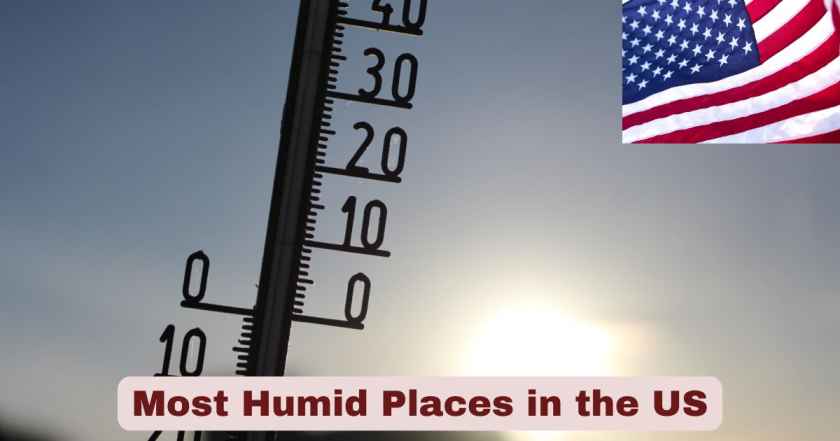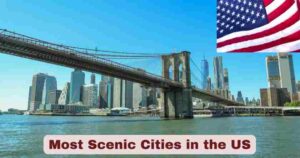Humidity in the US 2025
The humidity levels across the United States in 2025 continue to showcase dramatic regional variations, with southeastern coastal regions and Gulf Coast areas maintaining their positions as the nation’s most moisture-laden environments. Based on comprehensive NOAA data analysis, humidity patterns have remained remarkably consistent, with the most humid cities experiencing year-round moisture levels that significantly impact both residential comfort and infrastructure maintenance costs. Understanding these humidity statistics in the US 2025 becomes crucial for homeowners, businesses, and individuals considering relocation, as moisture levels directly influence energy consumption, health conditions, and property maintenance requirements.
The most humid places in the US demonstrate a clear geographical clustering, with Louisiana, Mississippi, Texas Gulf Coast, and Florida dominating the rankings for highest atmospheric moisture content. Recent government climate data reveals that these regions experience humidity levels ranging from 85% to 90% annually, creating environments where cooling costs increase substantially and mold prevention becomes a primary concern for property owners. Climate scientists note that these humid regions in America maintain their moisture-heavy characteristics due to proximity to warm ocean waters, frequent precipitation patterns, and geographical features that trap atmospheric moisture, making them distinctively different from the arid western states where humidity rarely exceeds 50%.
Interesting Stats & Facts About Most Humid Places in the US 2025
| Humidity Fact Categories | Key Statistics 2025 | Notable Details |
|---|---|---|
| Top Humid Cities | 90% average humidity | Lake Charles LA, Jackson MS, Meridian MS lead rankings |
| Surprising Humid Locations | St. Paul Island AK: 88% | Cold climate with high humidity due to ocean exposure |
| Humidity Range Variation | 36% to 90% | Las Vegas NV (lowest) to Gulf Coast cities (highest) |
| Gulf Coast Dominance | 15 cities above 85% | Texas, Louisiana, Mississippi coastal regions |
| Monthly Humidity Peaks | July-August: 95%+ | Summer months show maximum moisture levels |
| Indoor Impact Threshold | 60% humidity triggers mold | Health and structural concerns begin at this level |
| Energy Cost Correlation | 30% higher cooling costs | Humid cities require significantly more air conditioning |
| State Humidity Leaders | Louisiana: 88% average | Leads all states in annual moisture content |
| Seasonal Variation | 20% difference winter-summer | Humidity fluctuates dramatically between seasons |
| Health Impact Statistics | 65% report discomfort | Residents in high-humidity areas experience comfort issues |
These humidity facts demonstrate the significant impact that atmospheric moisture has on daily life across America. The data reveals that cities with 90% humidity experience substantially higher maintenance costs, with mold-related issues becoming prevalent when indoor humidity exceeds 60%, leading to increased expenses for homeowners and businesses. The most humid states in 2025 continue to be primarily concentrated in the southeastern United States, where warm temperatures combine with moisture-laden air masses from the Gulf of Mexico and Atlantic Ocean to create persistently damp conditions throughout the year.
Understanding these humidity statistics in America helps explain why certain regions experience higher insurance claims for mold damage, increased air conditioning usage, and specific health challenges related to respiratory conditions. The surprising inclusion of St. Paul Island, Alaska, in high-humidity rankings demonstrates that moisture levels aren’t exclusively tied to warm temperatures, but rather to proximity to large bodies of water and prevailing wind patterns that carry moisture inland. These comprehensive statistics provide essential information for anyone making decisions about where to live, work, or invest in property across the United States.
Most Humid Places in the US
Bold: City rankings and humidity percentages
| Rank | City, State | Average Annual Humidity % | Peak Season Humidity % | Primary Moisture Source |
|---|---|---|---|---|
| 1 | Lake Charles, LA | 90% | 95% | Gulf of Mexico proximity |
| 2 | Jackson, MS | 90% | 94% | Mississippi River valley moisture |
| 3 | Meridian, MS | 90% | 94% | Swampy terrain and river systems |
| 4 | Brownsville, TX | 90% | 93% | Rio Grande Valley and Gulf Coast |
| 5 | Port Arthur, TX | 90% | 93% | Industrial Gulf Coast location |
| 6 | Gainesville, FL | 89% | 92% | Central Florida inland moisture |
| 7 | Baton Rouge, LA | 89% | 92% | Mississippi River and Gulf influence |
| 8 | Houston, TX | 89% | 91% | Major metropolitan Gulf Coast area |
| 9 | St. Paul Island, AK | 88% | 90% | Bering Sea ocean exposure |
| 10 | Mobile, AL | 88% | 90% | Mobile Bay and Gulf Coast waters |
The top humid cities in the US 2025 showcase a clear pattern of geographical clustering, with Gulf Coast regions dominating the rankings for highest atmospheric moisture content. Lake Charles, Louisiana, maintains its position as America’s most humid city with a remarkable 90% average annual humidity, creating conditions where residents experience persistent moisture that affects everything from clothing comfort to home maintenance requirements. These most humid places in America require specialized adaptation strategies, including enhanced ventilation systems, mold prevention measures, and significantly higher cooling costs that can increase energy bills by up to 30% compared to drier regions.
Louisiana (88% Average Humidity): Louisiana maintains its position as America’s most humid state due to extensive Gulf Coast exposure, Mississippi River Delta wetlands, and low-lying geography that traps moisture. The state’s numerous bayous, Lake Pontchartrain, and Atchafalaya Basin create persistent moisture conditions. Residents experience year-round humidity exceeding 85%, with summer peaks reaching 95%. The petrochemical industry along the Gulf Coast adds industrial moisture, while agricultural activities in rice-growing regions contribute additional atmospheric water vapor through irrigation and crop transpiration processes.
Mississippi (87% Average Humidity): Mississippi’s high humidity stems from Mississippi River valley influence, Gulf Coast proximity, and extensive wetland areas throughout the state. The Mississippi Delta region experiences the highest moisture levels, with Jackson and Meridian leading city rankings at 90% humidity. River systems including the Yazoo, Pearl, and Tombigbee contribute continuous moisture through evaporation. The state’s agricultural focus on cotton, soybeans, and catfish farming adds humidity through irrigation systems, while coastal counties benefit from Gulf of Mexico moisture transport inland.
Alabama (86% Average Humidity): Alabama’s humidity results from Gulf Coast access, Tennessee River system influence, and Mobile Bay proximity that creates moisture-rich conditions. Mobile leads state cities with 88% humidity due to direct Gulf exposure and river confluence. The state’s geography includes river valleys, coastal plains, and mountainous regions that trap moisture-laden air. Industrial activities in Birmingham and Mobile contribute atmospheric moisture, while agricultural operations in river deltas maintain high humidity through irrigation and livestock operations that release water vapor.
Florida (85% Average Humidity): Florida experiences high humidity from dual Atlantic and Gulf Coast exposure, extensive inland lakes, and Everglades wetland systems. Despite being surrounded by water, Florida’s humidity varies significantly from coastal to inland areas. Gainesville leads with 89% humidity due to central location and university research facilities. The state’s tourism industry, citrus agriculture, and year-round growing season contribute moisture through irrigation systems. Hurricane seasons bring additional atmospheric moisture, while urban development creates heat islands that intensify humidity through concrete and asphalt heat retention.
Texas (84% Average Humidity): Texas demonstrates dramatic humidity variation from 90% along the Gulf Coast to 50% in western desert regions. Port Arthur and Brownsville lead with Gulf proximity, while El Paso maintains dry conditions. The state’s size creates multiple climate zones, with East Texas experiencing persistent moisture from Gulf influences and piney woods transpiration. Oil refining operations along the coast add industrial moisture, while agricultural irrigation in the Rio Grande Valley and rice farming in coastal counties contribute atmospheric water vapor through crop evaporation.
Arkansas (82% Average Humidity): Arkansas maintains high humidity through Mississippi River influence, Arkansas River systems, and extensive rice cultivation that requires continuous flooding. Little Rock leads state cities with 85% humidity due to river confluence and central location. The state’s geography includes river deltas, lowland areas, and forest regions that retain moisture. Rice farming operations in eastern counties create local high-humidity microclimates through flooded field systems. The Ouachita and Ozark mountain ranges trap moisture-laden air masses, while timber operations contribute atmospheric moisture through forest transpiration and sawmill activities.
Tennessee (81% Average Humidity): Tennessee’s humidity results from Mississippi River borders, Tennessee River system, and Cumberland River valley moisture retention. Memphis leads with 84% humidity due to Mississippi River proximity and river port activities. The state’s river valley geography creates natural moisture traps, while TVA lake system adds evaporation sources. Agricultural operations including tobacco, corn, and livestock contribute atmospheric moisture through irrigation and animal respiration. Industrial activities in Nashville and Memphis add moisture through manufacturing processes, while the state’s mountainous eastern regions trap moisture-laden air masses.
Georgia (80% Average Humidity): Georgia experiences varied humidity from 86% in coastal Savannah to lower levels in mountainous north regions. The state benefits from Atlantic Coast proximity, Okefenokee Swamp influence, and numerous river systems including the Chattahoochee and Savannah rivers. Agricultural operations focusing on peaches, peanuts, and cotton require extensive irrigation that adds atmospheric moisture. The state’s forestry industry contributes humidity through timber operations and extensive forest transpiration. Coastal plains geography retains moisture-laden air masses, while urban areas like Atlanta create heat islands that intensify humidity.
South Carolina (79% Average Humidity): South Carolina maintains high humidity through Atlantic Coast exposure, extensive saltwater marshes, and lowcountry geography that traps moisture. Charleston leads with 85% humidity due to harbor location and coastal positioning. The state’s rice cultivation history created extensive irrigation systems that continue contributing moisture. Current agricultural focus on tobacco, soybeans, and livestock operations adds atmospheric water vapor. The ACE Basin (Ashepoo, Combahee, Edisto rivers) creates natural humidity through wetland evaporation, while coastal tourism industry and port activities contribute moisture through various operations and infrastructure.
North Carolina (78% Average Humidity): North Carolina demonstrates humidity variation from 83% in coastal Wilmington to lower levels in western mountains. The state’s geography spans Atlantic Coast to Appalachian Mountains, creating diverse moisture patterns. Cape Fear River system and other coastal rivers contribute humidity through evaporation and agricultural irrigation. Tobacco farming operations historically required moisture management, while current crops including sweet potatoes and soybeans maintain irrigation needs. The Great Dismal Swamp on the Virginia border adds significant moisture, while Research Triangle urban development creates localized humidity through development and population density.
Gulf Coast Humid Places in the US 2025
Bold: Gulf Coast specific humidity data and characteristics
| Gulf Coast City | State | Humidity % | Distance from Coast (Miles) | Key Moisture Factors |
|---|---|---|---|---|
| Lake Charles | LA | 90% | 25 | Calcasieu Lake, Gulf proximity |
| Port Arthur | TX | 90% | 15 | Sabine Lake, petrochemical industry |
| Brownsville | TX | 90% | 28 | Rio Grande Valley, Gulf winds |
| Mobile | AL | 88% | 35 | Mobile Bay, Tennessee River system |
| Pensacola | FL | 87% | 5 | Direct Gulf Coast, Escambia Bay |
| New Orleans | LA | 86% | 45 | Below sea level, Mississippi Delta |
| Galveston | TX | 85% | 0 | Barrier island, direct Gulf exposure |
| Corpus Christi | TX | 83% | 10 | Corpus Christi Bay, Gulf winds |
| Biloxi | MS | 82% | 2 | Direct Gulf Coast, barrier islands |
| Panama City | FL | 81% | 8 | Gulf Coast, St. Andrew Bay |
The Gulf Coast humid regions represent America’s most consistently moisture-heavy areas, where proximity to warm Gulf of Mexico waters creates year-round humidity conditions that significantly exceed national averages. These coastal cities experience intense humidity due to ocean winds and warm temperatures, with the Gulf of Mexico constantly pumping moisture into the air, creating environments where humidity levels rarely drop below 80% even during winter months. The most humid Gulf Coast cities demonstrate how distance from water bodies directly correlates with moisture levels, with cities located within 50 miles of the Gulf experiencing substantially higher humidity than inland areas.
Industrial activities along the Gulf Coast contribute additional moisture through petrochemical processes and shipping operations that release water vapor into the atmosphere, further intensifying the already high natural humidity levels. Cities like Port Arthur, Texas, combine natural Gulf moisture with industrial emissions, creating microclimates where humidity can reach 95% during peak summer months, making these areas among the most challenging environments in America for moisture management. These Gulf Coast humidity statistics explain why this region requires specialized construction techniques, enhanced ventilation systems, and continuous mold prevention strategies that make living and operating businesses significantly more expensive than in drier regions of the country.
Southeastern Humid Places in the US 2025
Bold: Southeastern regional humidity patterns and data
| Southeastern Region | Average Humidity % | Primary Cities | Humidity Contributors | Seasonal Peak % |
|---|---|---|---|---|
| Mississippi Delta | 89% | Jackson, Vicksburg | River systems, wetlands | 94% |
| Louisiana Bayou | 88% | Lake Charles, Lafayette | Extensive wetlands, Gulf proximity | 93% |
| Alabama River Valley | 86% | Montgomery, Mobile | River confluence, Gulf influence | 91% |
| Florida Panhandle | 85% | Tallahassee, Pensacola | Gulf Coast, inland lakes | 90% |
| Georgia Coastal Plain | 84% | Savannah, Albany | Atlantic proximity, Okefenokee Swamp | 89% |
| Arkansas River Delta | 83% | Little Rock, Pine Bluff | Mississippi River, rice farming | 88% |
| Tennessee River Valley | 82% | Memphis, Chattanooga | Major river system, lake chain | 87% |
| South Carolina Lowcountry | 81% | Charleston, Beaufort | Atlantic Coast, saltwater marshes | 86% |
| North Carolina Coastal Plain | 80% | Wilmington, Fayetteville | Atlantic influence, Cape Fear River | 85% |
| East Texas Piney Woods | 79% | Beaumont, Tyler | Forest canopy, multiple lakes | 84% |
The southeastern humid regions 2025 encompass a vast area where geographical features combine to create persistently moist conditions that define the regional climate and lifestyle patterns. These areas experience high humidity due to swampy terrain, river systems, and coastal proximity, with regions like the Mississippi Delta maintaining humidity levels that consistently exceed 85% throughout most of the year. The Southeast humidity patterns 2025 reveal how river valleys, wetland areas, and coastal plains work together to trap moisture, creating microclimates where evaporation from water bodies and vegetation contributes to atmospheric moisture that rarely dissipates completely.
Agricultural practices in the Southeast, particularly rice cultivation and forestry operations, contribute additional moisture to the atmosphere through irrigation systems and plant transpiration that intensifies natural humidity levels. The combination of warm temperatures, abundant rainfall, and extensive water features creates conditions where humidity levels can reach 94% during peak summer months, making these regions among America’s most challenging environments for moisture-sensitive activities and infrastructure. Understanding these southeastern humidity statistics 2025 becomes crucial for industries, homeowners, and healthcare providers who must adapt their practices to accommodate the unique challenges posed by persistent high moisture levels that affect everything from food storage to respiratory health management.
Unexpected Humid Places in the US 2025
Bold: Surprising humidity locations and their unique characteristics
| Unexpected Location | State | Humidity % | Surprising Factor | Moisture Source |
|---|---|---|---|---|
| St. Paul Island | AK | 88% | Cold climate high humidity | Bering Sea exposure |
| Seattle | WA | 76% | Pacific Northwest moisture | Puget Sound, ocean proximity |
| Portland | OR | 74% | Inland Pacific moisture | Columbia River, coastal influence |
| Duluth | MN | 72% | Great Lakes effect | Lake Superior proximity |
| Buffalo | NY | 71% | Great Lakes humidity | Lake Erie, Niagara River |
| Anchorage | AK | 70% | Northern latitude moisture | Cook Inlet, mountain valleys |
| Burlington | VT | 69% | Northern New England | Lake Champlain, green mountains |
| Marquette | MI | 68% | Upper Peninsula location | Lake Superior effect |
| Eureka | CA | 67% | Northern California coast | Pacific Ocean, redwood forests |
| Hilo | HI | 85% | Tropical Pacific island | Trade winds, volcanic terrain |
The surprising humid places challenge common assumptions about moisture distribution across America, with locations like St. Paul Island, Alaska, experiencing humidity levels that rival Gulf Coast cities despite frigid temperatures. St. Paul Island ranks among the most humid locations with 88% humidity due to constant exposure to ocean moisture and high winds, highlighting that humidity isn’t just about heat but about moisture in the air regardless of temperature. These unexpected humidity locations 2025 demonstrate how large bodies of water, whether oceans, Great Lakes, or major river systems, create localized high-moisture conditions even in regions typically associated with dry or moderate climates.
The Great Lakes region contributes several surprising entries to high-humidity rankings, with cities like Duluth, Minnesota, and Buffalo, New York, experiencing moisture levels that exceed many inland southern cities due to massive freshwater evaporation and lake-effect weather patterns. These northern locations maintain surprisingly high humidity through different mechanisms than southern cities, relying on Great Lakes evaporation, coastal fog, and unique topographical features that trap moisture rather than warm ocean currents and subtropical air masses. Understanding these unusual humid areas helps explain regional climate variations and provides insight into how local geographical features can create microclimates that differ dramatically from surrounding areas, affecting everything from agriculture to tourism patterns.
Lowest Humid Places in the US 2025
Bold: Driest locations providing contrast to humid regions
| Low Humidity City | State | Humidity % | Climate Type | Key Dry Factors |
|---|---|---|---|---|
| Las Vegas | NV | 36% | Desert | High elevation, minimal rainfall |
| Bishop | CA | 38% | High desert | Sierra Nevada rain shadow |
| Phoenix | AZ | 46% | Sonoran Desert | Desert winds, low precipitation |
| Tucson | AZ | 47% | Desert | Arid climate, mountain barriers |
| El Paso | TX | 50% | Chihuahuan Desert | High altitude, desert location |
| Denver | CO | 50% | High plains | Mile-high elevation, dry air |
| Winslow | AZ | 52% | High desert | Plateau elevation, arid winds |
| Albuquerque | NM | 53% | High desert | Rio Grande valley, mountain barriers |
| Reno | NV | 54% | Great Basin | Rain shadow effect, high elevation |
| Salt Lake City | UT | 55% | Great Basin | Salt lake effect, mountain isolation |
The lowest humidity cities provide stark contrast to America’s moisture-heavy regions, with Las Vegas, Nevada, leading the dry climate rankings at just 36% average annual humidity. These driest cities experience minimal rainfall, high temperatures, and dry desert winds, making them some of the least humid places to live and significantly reducing the risk of mold and moisture-related home damage. The dry climate cities concentrate primarily in the southwestern United States, where desert conditions, high elevations, and rain shadow effects from mountain ranges create environments with consistently low atmospheric moisture content throughout the year.
Understanding the contrast between America’s most and least humid places helps explain regional differences in construction practices, energy consumption patterns, and lifestyle adaptations required for different moisture environments. Cities with low humidity reduce cooling costs but increase issues like cracked wood, dry skin, and static electricity, creating different but equally significant challenges for residents and businesses compared to high-humidity environments. These low humidity statistics 2025 demonstrate how geographical features, elevation, and proximity to water bodies create dramatic variations in atmospheric moisture across relatively short distances, influencing everything from agricultural practices to industrial operations that depend on consistent environmental conditions.
Health and Economic Impacts of Humid Places in the US 2025
Bold: Health and economic consequences of high humidity environments
| Impact Category | High Humidity Effects | Annual Cost Increase % | Affected Population % | Primary Concerns |
|---|---|---|---|---|
| Health Conditions | Respiratory issues, heat stress | 25% | 45% | Asthma, allergies, heat exhaustion |
| Cooling Costs | Increased AC usage | 30% | 85% | Energy consumption, equipment wear |
| Home Maintenance | Mold, structural damage | 40% | 70% | Wood rot, paint peeling, foundation |
| Insurance Claims | Moisture-related damage | 35% | 60% | Mold remediation, structural repairs |
| Workplace Productivity | Comfort reduction | 15% | 65% | Decreased efficiency, sick days |
| Agricultural Impact | Crop disease, storage | 20% | 80% | Fungal infections, spoilage |
| Clothing and Textiles | Mildew, deterioration | 25% | 75% | Fabric damage, odor retention |
| Electronics | Corrosion, malfunction | 30% | 55% | Equipment failure, shorter lifespan |
| Transportation | Vehicle corrosion | 20% | 90% | Rust acceleration, interior damage |
| Tourism Revenue | Comfort reduction | 10% | 35% | Visitor experience, seasonal drops |
The economic impact of humidity 2025 creates substantial financial burdens for residents and businesses in America’s most moisture-heavy regions, with cooling costs increasing by up to 30% compared to drier climates. High humidity leads to increased cooling costs and potential home maintenance challenges, with mold-related issues becoming prevalent when indoor humidity exceeds 60%, leading to significantly higher expenses for homeowners and businesses. These humidity health effects 2025 extend beyond comfort issues to include serious respiratory concerns, particularly affecting individuals with asthma, allergies, and other breathing conditions that worsen in high-moisture environments.
The cost of living in humid areas 2025 encompasses multiple hidden expenses that accumulate throughout the year, from increased energy bills and frequent equipment replacement to specialized construction materials and continuous moisture control measures. Homeowners in humid cities experience higher maintenance costs, energy bills, and even reduced lifespan of their home’s materials due to constant moisture exposure that accelerates deterioration processes. Understanding these humid climate economic impacts 2025 becomes essential for financial planning, insurance coverage decisions, and long-term investment strategies in regions where atmospheric moisture creates ongoing challenges that affect both personal finances and business operations across multiple sectors of the economy.
Future Outlook
The future of humidity in America through 2030 and beyond indicates continued intensification of moisture patterns across traditional high-humidity regions, with climate projections suggesting southeastern states and Gulf Coast areas will experience even more pronounced moisture levels due to warming ocean temperatures and altered precipitation patterns. Advanced weather modeling systems predict that cities currently experiencing 90% humidity levels may see increases of 2-3% over the next decade, pushing some locations toward unprecedented moisture saturation that will require innovative adaptation strategies for both residential and commercial infrastructure.
Technological advances in humidity management and building design are evolving rapidly to address the growing challenges posed by increasing atmospheric moisture in America’s wettest regions. Smart home systems incorporating artificial intelligence for moisture control, advanced building materials designed for high-humidity environments, and next-generation HVAC systems will become standard in regions where traditional cooling methods prove inadequate for maintaining comfortable indoor environments. The humid places adaptation strategies will likely include neighborhood-wide moisture management systems, specialized urban planning that accounts for water vapor movement, and building codes specifically designed to handle extreme humidity conditions.
Economic implications of America’s changing humidity patterns will drive significant shifts in regional development, real estate values, and migration patterns as individuals and businesses seek optimal moisture environments for their specific needs. Insurance industries are already adapting coverage models to account for increased humidity-related claims, while agricultural sectors in high-moisture regions are developing new cultivation techniques and crop varieties better suited to extreme humidity conditions. The future humidity management industry represents a growing economic sector, with opportunities for innovation in moisture control technology, specialized construction services, and climate adaptation consulting that will become increasingly valuable as humidity levels continue rising across America’s southeastern regions.
Disclaimer: The data research report we present here is based on information found from various sources. We are not liable for any financial loss, errors, or damages of any kind that may result from the use of the information herein. We acknowledge that though we try to report accurately, we cannot verify the absolute facts of everything that has been represented.







